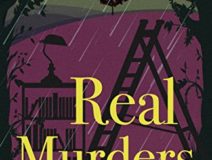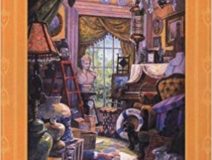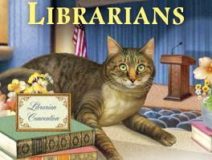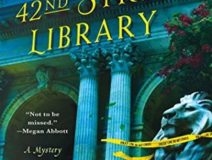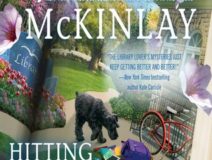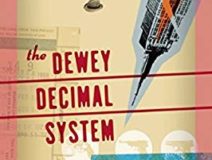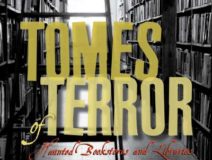A library reflects the communities and the cultures in which it operates, and library collections and programs reflect the reading tastes, the history and the priorities of the residents.

A library is: MURDER
When Rudi Denham first started in the world of libraries, she thought she knew how to define a library. Throughout her career, libraries continually challenged and surprised her. Interested in exploring the wider perspective of libraries, in this four-part series, Rudi presents a select reading list for library lovers, along the following themes:
- Place
- People
- Community
- And last but not least … Murder!
So far in this series, we’ve explored the connection between the library as place, as people and as community. But what’s the connection between libraries and murder?! Have you ever noticed how often murders are solved by library staff, are committed by librarians or occur in a library? As Detective Mike Cosgrove says in Murder at the 42nd Street library, “You can never tell about these bookworm types once they take off their glasses and let their hair down” (Lehane, 2016, p. 153). Some of them, like Mary Jane Maffini, become crime writers.
In my years as a crime writer, I have been intrigued to learn how many of my colleagues have also been librarians or library staffers. Was the library fertile ground for our plots? Did access to all those mysteries make us look at our surroundings differently? Was it the perilous capacity of sliding stacks? The possibility of someone lurking in the far reaches of the reference department after closing? The surprising borrowing habits of some meek patron? Did dangerous ideas pop into our heads as we went about our routine tasks? Or was it simply too many meetings when the imagination can turn to murder?
Mary Jane Maffini, www.maryjanemaffini.com
Given the recent popularity of the new Hallmark TV movies based on Charlaine Harris’s Aurora Teagarden books (the first of which was Real murders, published in 1990 and reprinted in 2010), I searched for similar titles and found, well, dozens. I offer a selection here.
I’ve long been a fan of Miranda James’s Cat in the Stacks mystery series, featuring Charlie Harris. In Twelve angry librarians, Charlie is interim college library director in Athena, Massachusetts, and is assisted by his faithful sidekick, his Maine Coon cat, Diesel. When his nemesis from high school drops dead, Charlie is the number 1 suspect. Charlie has to find the real killer and worry about the possibility of his daughter and her husband, who are expecting his first grandchild, moving far away. The events that occurred at Charlie’s conference reminded me of the many conferences I’ve attended, though I’ve never seen anyone walk a cat on a leash!
In the library world, no building is more iconic than the New York Public Library at 42nd Street. Imagine a killer following his victim up the marble stairs, past the two guardian lions, straight to the office of the director of special collections, firing several fatal shots and then slipping out and disappearing into the subway. That’s the start of Con Lehane’s Murder at the 42nd Street library. “As much as he [Raymond Ambler] presented himself as a simple librarian living quietly among his books and papers, he thought of himself as a reincarnation of Sherlock Holmes—or lately, Lew Archer” (Lehane, 2016, p.106). The book ends in a shootout at the library, with bullets pinging off the steel shelving and burying themselves in books. Raymond Ambler is the director of the (fictional) true crime collection, and “he wondered if one day he would hold up a bullet pierced book at one of his lectures and recount the true crime adventure that ended in a shootout in the stacks” (Lehane, 2016, p. 290). Murder at the 42nd Street library features complex and memorable characters, and an ending you’ll never see coming.
“On a related topic,” Mary Jane Maffini writes, “I hope that the staff of Ottawa Public Library will have forgiven me for having my character Alvin Ferguson rip pages out of a serial. It was only once and he was under orders.”
Mary Jane Maffini, www.maryjanemaffini.com
Because this is a list for library lovers, I had to feature one of the books in Jenn McKinlay’s Library Lover’s mystery series. Hitting the books is an enjoyable cozy/romance, the ninth in this series by a former librarian, who is also the author of several other series, including the Cupcake Bakery Mysteries, the London Hat Shop Mysteries and the Bluff Point Romances.
Lindsey did a quick mental rundown of her day […] She had a meeting at nine o’clock with the library board, which had been in transition since its last president had been murdered. She hadn’t yet gotten a read on the new members and what their expectations of the library were. Mostly, they seemed relieved after every meeting to still be alive. She wasn’t sure what that said about her as library a director. She decided to bring muffins and hope that relaxed them a bit. After all, everyone liked muffins. (p. 2)
Another enjoyable read is Eva Gates’s Booked for trouble, a Lighthouse Library Mystery. At 30, Lucy Richardson tries to get out from under her mother’s influence by moving to Bodie Island and managing the Lighthouse Library. Then her proper and perfect mother is charged with murder. As Lucy herself says, “Who knew life in a library on the Outer Banks would be so interesting?” (Gates, 2015, p. 221). There’s also a budding romance, but will the winner be Connor the mayor or Butch the detective? I found myself rereading some of the passages because of the delightful way they were worded.
In case you’re thinking that all library mysteries are cozies, here are two more as a change of pace:
In The Dewey Decimal system by Nathan Larson, our nameless hero wanders a wrecked New York City, which was devastated after a terrorist attack, and often actually lives in the 42nd Street library. With its bleak outlook and high body count, The Dewey Decimal system is definitely not a cozy read.
Is there any truth in all of this murder and mayhem in libraries? So glad you asked! Tomes of terror: Haunted bookstores and libraries documents some of those strange activities in Canada and the United States, and internationally. According to witnesses, the ghostly spectre of a little girl haunted the Waterdown library building before the 2014 renovation. In Toronto’s Runnymede Branch, which later became a Chapters bookstore, there were reports of books flying off the shelves. Other haunted Canadian libraries and bookstores featured include Attic Books in London and the Spring Garden Road library in Halifax, which was built on a poorhouse cemetery. A man after my own heart, Mark Leslie ends with recommendations of “books about books” for further reading, including some of the titles featured here. Hamiltonian Leslie’s other titles include Haunted Hamilton and Macabre Montreal.
I hope you have enjoyed my personal exploration of what a library is and have found some of your own favourites.
Featured titles
Gates, E. (2015). Booked for trouble. NY: New American Library.
Harris, C. (2010). Real murders. NY: Berkley Books. (Original work published 1990)
James, M. (2017). Twelve angry librarians. NY: Berkley Prime Crime Books.
Larson, N. (2011). The Dewey Decimal system. NY: Akashic Books.
Lehane, C. (2016). Murder at the 42nd Street library. NY: Minotaur Books.
Leslie, M. (2012). Spooky Sudbury, Toronto: Dundurn.
Leslie, M. (2014). Tomes of terror: Haunted bookstores and libraries. To: Dundurn.
Leslie, M. (2018). Macabre Montreal, Toronto: Dundurn.
McKinlay, J. (2018). Hitting the books. NY: Berkley Prime Crime Books.
Recently retired after 35 years as a professional librarian, Rudi Denham is a freelance writer with multiple articles published in professional journals such as Feliciter, Access OLA and Open Shelf, as well as other magazines, such as The Fifth Column.
